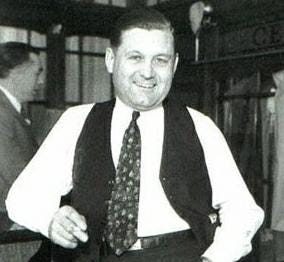A Chicago Mobster Murdered My Cousin
A footnote to Adaline’s Story (The murder of Patrick Corcoran)
In the story “The Unexpected Life of Adaline Geehan” (my 1st cousin, 3x removed), her passion and commitment to supporting and improving the rights of women is demonstrated as she led early efforts in Minneapolis to organize women in the workforce amidst the highly volatile labor movement of the 1930s.
At the same time, a man named Patrick Corcoran was working hard to organize and unite the Teamsters in Minneapolis. (Years later, his grandson extolled his grandfather’s ability to work with regular laborers and understand what their needs were and also be able to go into the boardroom and talk to the bosses and get his point across.)
Adaline and Patrick were first cousins, both of whom were living and working in Minneapolis at the same time for similar causes. Though there is no direct evidence of a mentor-like relationship between Adaline and Patrick, it’s hard to imagine that there wasn’t some type of connection. Patrick was the son of Adaline’s father’s sister and was older than her by almost two decades. As Adaline was beginning her career in the 1930s, Patrick was the Teamster Union Leader and at age 48, on a cold November night, was murdered.

The news made front-page headlines for months as new details emerged, suspects were questioned, and the funeral was had. It turns out that Pat had been threatened and assaulted previously, and it was “common talk” that “some labor leaders would be murdered” according to witnesses who gave testimony at a Coroner’s Inquest. This is not to say that the Union and the State of Minnesota were not doing everything possible to solve the case. Indeed, rewards totaling over $10,000 were being offered.
The paper reported nearly 7,000 people attended the funeral at St. Mary’s Basilica followed by an over 1,000 car procession to the cemetery. By order of the Joint Teamster’s Council, all truck driver’s in the city stopped work from 9 AM until noon out of respect for the man who had been working so tirelessly for their rights.
Unfortunately, in the end, though some arrests were made, the murder was never officially solved. But according to the news of the day, the most likely suspect was a “notorious Chicago underworld figure” – Bugs Moran. Moran’s Chicago North Side Gang was chief rival to Al Capone’s South Side Gang, especially during prohibition. After the infamous St. Valentine’s Day Massacre in February of 1929, Moran spent less time in Chicago and more in Minnesota, where he had been born. It’s no secret that the streets of St. Paul were “virtual training grounds for young crooks” in the early 1930s and though Moran was not in need of training by that time, he did have the potential to be a good trainer staying out of Capone’s way. (Source: https://www.fbi.gov/history/brief-history/the-fbi-and-the-american-gangster)

Gangsters don’t register their addresses with city directories, so it’s not easy to confirm exactly where Moran may have been staying when Pat was murdered. But I don’t think there would be credence to the multiple claims and testimonies that Moran was directly involved with the murder of Pat had he not been in the area.
Whether Adaline was close with her cousin or not, there is a high degree of likelihood that she attended the funeral and held the trauma close to her heart for years. It may have even been an impetus for digging in further to organize office workers—most of whom were women, and possibly for her involvement with the NAACP.
Adaline and Pat were first-cousins to each other and both are first cousins 3x removed to me. I, of course, never knew either of them, but I am impressed with their leadership and the fact that they each, in their own ways, blazed new trails in the pursuit of equality for others.




It turns out that Pat had been threatened and assaulted previously, and it was “common talk” that “some labor leaders would be murdered” What a courageous man!
Ho-ly crap! So interesting. Great detective work digging up this information, Kirsi. Have you read the novel by Steven Thayer, "Saint Mudd"? It takes place in St. Paul in the 1930s (if I remember correctly). This story reminds me of that.